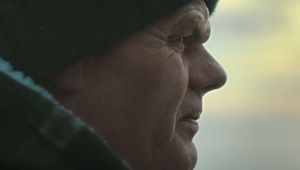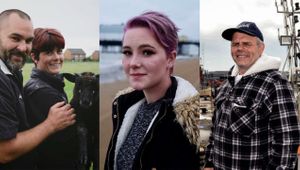
Your Shot: How Archer’s Mark and Saatchi LA Recreated the Experience of a Visually-Impaired Skier

Hurtling down the powdery slopes at 80 miles an hour takes stout heart and nerves of steel at the best of times, but when you’re visually impaired and relying on the directions of your sighted partner, it requires the kind of bravery that few can muster. Paralympian Menna Fitzpatrick is such skier and at this year’s event in PyeongChang she and her partner Jen Kehoe won two silvers and a bronze for Team GB.
They also took part in a project for Toyota, Worldwide Paralympic Partner, called ‘Start Your Impossible’. As part of this campaign, devised by Saatchi & Saatchi LA, Menna and Jen starred in a short film and took part in a VR project that explored the experience of being a skier who happens to be visually impaired. LBB caught up with production company Archer’s Mark and the team at Saatchi & Saatchi LA to find out more.
LBB> What was it like working with Menna?
Archer’s Mark> Menna and her guide Jen Kehoe are two of the most inspiring and positive athletes we’ve ever worked with, and we knew from the first moment we met the two of them that the process of making these films together would be a truly collaborative experience.
Menna was very open about sharing her medical records, which provided us with immediate insight into her level of visual impairment, and she and Jen had also created a DIY version of a visual impairment filter, by taping up a set of skiing goggles which we could all wear to understand in rough terms how she saw the world around her.
We were also very fortunate to be able to work closely with Menna and Jen’s coach, John Clark, who not only shared a huge amount of knowledge in relation to para-skiing, but also helped ensure that all of the training activities were authentically demanding on screen…
Both Menna and Jen never flinched at the long and demanding shoot days, even when asked to swim in an outdoor pool in sub-zero conditions, attack another HIIT (High Intensity Interval Training) session, or throw themselves down the slopes for one final take.
By the end of the week it felt like we were waving off family, and it’s been a total joy seeing the pair of them accumulate so many well-deserved medals in PyeongChang (they’ve won two silvers and bronze at the time of going to press)!
Saatchi LA> Menna and Jen are more than just inspiring athletes. They truly embody the passion and dedication that you must have in order to be a Paralympian. Their close bond is apparent the moment you meet them. They finish each other’s sentences, laugh constantly and are never apart. It is clear that their trust in each other is one of their greatest athletic advantages.
Menna bonded instantly with our director, Michelle Coomber. That trust was essential in capturing this truly personal, intimate story. We were constantly looking for feedback from them and they were always quick to tell us if something wasn’t authentic. It was an incredibly collaborative shoot and the set was always filled with laughter.
LBB> And when it came to recreating the experience of Menna and the other Paralympian skiers, you worked with the Royal Institute for the Blind and ophthalmic consultants – what sort of insights did they bring to the process? And were there any that you found particularly surprising?
Archer’s Mark> A lot of the insights chimed very much with our experience of working with the RNIB and medical experts throughout the production of Notes on Blindness, but blindness is of course a condition that affects everyone differently, so we also gained plenty of new insights specific to Menna’s experience as an elite athlete.
In Menna’s case, she has bilateral severe visual loss caused by a condition called 'congenital retinal folds’. In Menna, this causes almost total blindness in one eye and a markedly constricted visual field in the other. She also has an extensive temporal defect and a small central area of poor quality vision.
I think one of the biggest surprises – flagged to us both by our ophthalmic team and Menna herself, was how much her sight is affected by light conditions. It seems obvious now, but it’s incredible to understand how overcast conditions can so dramatically reduce Menna’s ability to orient herself on the slopes.
LBB> In terms of the intro film, which follows Menna in her training, where did you go to shoot this and what were the production challenges involved?
Archer’s Mark> Shooting outside the core skiing season was our first challenge, and so this led us to Hintertux, in Austria – one of only two ski resorts worldwide to offer good skiing conditions at any time of year.
The slope management team at the resort were incredibly accommodating, ensuring that we had the time and space we needed to shoot, despite the fact that several national Paralympic ski teams were deep in their own preparations for PyeongChang during the same week.
The other issue was the constantly changing weather conditions at that time of year. Typically, the weather was perfect on our recce, but was much more changeable by the time we arrived for the shoot. Knowing how much footage we needed to capture, both on the slopes and down in the valley, our producer (Kirsty Lane) would write up a dual schedule every day, which would allow us to make the most of any windows of good weather on the mountain, whilst also ensuring we could avoid losing time by shooting an interior set up in the event of poor weather. This was a massive effort, and we were all pretty nervous after failing to get onto the slopes for the first two days, but it paid off in spades when we were able to capture footage of Menna and Jen in perfect skiing conditions on days three and four.
Saatchi> The intro film and really, the whole production, was a massive undertaking. The amount of content we had to shoot in such a short time frame posed quite a challenge. The weather was a major factor. Right off the bat, we had to change our schedule to accommodate for a blizzard on the first day of shooting. Not to mention the huge challenge of shooting on a ski slope. Some of us had to ski down from the top of the mountain just to get to our shoot location (we weren’t complaining).
Hintertux was an incredible background for the films. It’s honestly a shame that all the footage is blurry because the landscape was incredible. Also coincidentally, Hintertux was the mountain that Menna had broken her hand on the year before.
LBB> There are some lovely moments in the film – the bit where Menna is feeling the snow with her bare hands in order to get an idea of the conditions felt like a really poignant insight into how she must approach her ski runs differently, using her other senses. How did you go about working with Menna to find out about the details of her routine and to figure out which elements would make for interesting content in the film?
Archer’s Mark> Archer’s Mark specialises in filming elite athletes, so we had done a decent amount of research on para-skiers’ training routines and had a clear idea of the kind of content we would be capturing. But – as is always the case when working with athletes – it’s the specifics and quirks of their personalities that add such a great level of authenticity to the final product.
There was a particularly lovely moment when we saw Menna and Jen whispering to each other on the start line before a take, and we weren’t sure what to make of it. (Director) Michelle (Coomber) had a quiet word with them and they admitted that they usually launch themselves down the slope with a giant ‘roar’, to motivate themselves – but they weren’t sure whether we would want it in the film. Of course we loved it, and it’s a great statement of their personalities and testament to the chemistry we had on set that we were able to capture moments like these.
Saatchi> One of the challenges of shooting a Paralympian is not bringing your own preconceived notion of their abilities to the shoot. We didn’t tell Menna what to do. She just did her thing, and we captured it. It’s all those little moments that truly help the viewer understand what her world is like. Many of the best moments were caught organically.
LBB> What I thought was brilliant about the intro film was that it was from Menna’s point of view, she was telling her own story and it didn’t lay the sentimentality on thick. She was respected as an athlete rather than being spoken down to or held up on a pedestal – what conversations did you have with the agency and Menna herself about the sort of tone you wanted to strike?
Saatchi> The intro film was really just that. A chance for Menna to introduce herself. Her voiceover addresses the challenges that she has, but it’s very matter of fact. You never feel sorry for her. From the beginning, it was very clear that once you put Menna in her element, you can’t help but be wowed by her.
@SeeLikeMenna is a part of a larger initiative by Toyota to elevate the Paralympics and Paralympians. It was extremely important to us to strike the right tone in all of the @SeeLikeMenna films as well as the intro film. Paralympians are undeniably inspiring athletes, but their accomplishments are often presented with asterisk. The truth is, they train and compete just as hard as Olympians. They deserve recognition for their athletic accomplishments beyond just competing with an impairment. They don’t dwell on their disability, so neither did we.
LBB> As a production company it’s not the first time Archer’s Mark has explored visual impairment, with the award-winning Notes on Blindness. How did that experience lay the foundation for this project? And how did they differ?
Archer’s Mark> We were fortunate that the very long process of developing, producing and distributing Notes on Blindness allowed us the time to forge many strong connections between organisations and individuals within the blind community. There were several striking similarities between the projects – not least the one you mentioned above, which was to treat our protagonists as fully rounded individuals who happened to be blind, rather than ciphers who needed to represent the entire blind community.
Certainly, one of the earliest insights we shared with SSLA was the fact that only 5% of those registered blind actually have no light perception at all, and so each of the remaining 95% see the world in a way that’s particular to them. Hence why we had to work so closely with Menna, Jen and the medical team properly to represent her worldview.
LBB> So when it came to the p.o.v skiing shots at the end of the film and also in the 360 video, what sort of rigs did you use?
Archer’s Mark> We experimented with several different head-mounted rigs and lens combinations before deciding on the ideal rigs for each component of the shoot. For both set-ups, it was crucial that we didn’t overload the skiers’ helmets, as even a relatively small amount of additional weight could have had a serious impact on their balance.
For the POV footage, we used a gimbal fitting to address some (but not all!) of the shake generated by Menna’s movement down the slope, as it needed to be watchable without feeling unrealistically steady.
For the 360 shoot, we had to be even more careful about camera placement, shooting front and rear cameras as close as possible to Menna’s eyeline, so that viewers would look down and around from the correct height. This made the stitching trickier than it would have been had we used a more conventional 360 mount on top of the helmet, but we were also able to do some head removal in post, so it really does feel like you’re sharing Menna’s eyeline when speeding down the slopes.
LBB> I’m guessing that shooting 360 while zooming downhill would be extra tricky – what sort of challenges did it present and how did you overcome them?
Archer’s Mark> As described above, it was critical that we shot with a lightweight rig so that there was no risk that Menna could be unbalanced by the helmet rig.
We also had to consider the fact that each of the three different athletes we worked with on the 360 film (Menna, along with Slovenia’s Maciej Krezel and Slovak athlete Marek Kubacka) skied with a different head position, which was dictated both by aerodynamics and the nature of their visual impairment (Menna is a B2 athlete, whereas Maciej is a B3 and Marek competes in the B1 category). This meant we had to reset and re-rig the camera when switching between athletes, and review test footage before going for a take.
Even with Marek (who is a B1 skier and therefore has no light perception at all), we wanted to shoot his POV, so that we could accurately track the gates into the 360 environment in post-production, and sighted users could orient themselves even when ‘losing’ their vision.
LBB> Audio is always interesting when it comes to 360 – and this time you had to consider not only the ambient sound but the sound of her sighted guide. How did you record and integrate that into the mix?
Archer’s Mark> From the very start of the process, both we and the Saatchi & Saatchi LA creative team were adamant that sound had to be at the heart of the See Like Menna experience. For all that the visual impairment filter is a striking statement of the way in which Menna sees the world, it’s also critical that the viewer has to depend primarily on the audio track to really interpret the world around them – just as Menna has to do when speeding down a mountain at 100km/h.
We therefore recorded both binaural and ambisonic sound, with our awesome skiing soundie Jono Cary deploying different mics for the various different strands of content (each would be delivered on a different platform, with different audio specs). We also recorded close mic tracks from Menna’s guide, Jen, which we could then spacialise in post-production, better to represent what Menna hears through her Bluetooth headset when heading down the slopes
For this part of the process, we worked closely once again with the super-talented Supervising Sound Designer Joakim Sundström (with whom we collaborated on Notes on Blindness) to deliver fully spacialized sound mixes which truly immerse the viewer in Menna’s world.
Saatchi> AM nailed it.
LBB> How does the story of Menna and the other Paralympians feed into the wider Toyota ‘Start Your Impossible’ campaign?
Saatchi> ‘Start Your Impossible’ is challenge to the world. By sharing Menna’s story, we hope to inspire everyone to question their limits and take on the biggest obstacles in their life. On a higher level, we hope to change perceptions of not only Paralympians, but of all people living with disabilities. Toyota believes that better mobility will create a better society, because “when we are free to move, anything is possible.”










